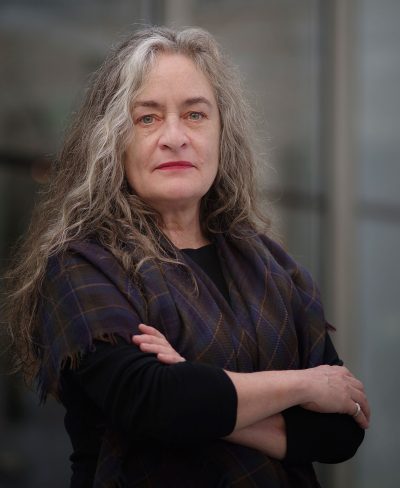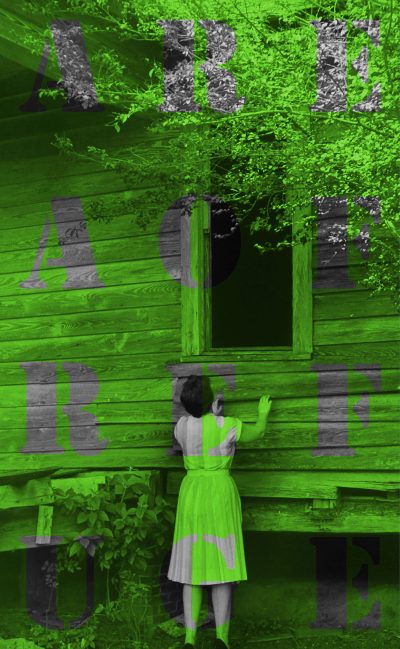Advertisement
At MFA, Brookline Artist Annette Lemieux Uses Old Movies To Address Today’s Anxieties

In Annette Lemieux’s new exhibition “Mise en Scène,” on view at Boston’s Museum of Fine Arts from Sept. 24 to March 4, the Brookline artist riffs on images from scenes in old movies — Charlie Chaplin satirizing Hitler in his 1940 film “The Great Dictator,” the balloon the murderer uses to abduct a girl in Fritz Lang’s 1931 film “M,” television antennas rising from rooftops in the opening credits of François Truffaut’s 1966 film adaptation of “Fahrenheit 451."

“What Annette has done is taken key images and objects out of these films that influenced her as a child and brought them into our contemporary space today,” MFA curator Liz Munsell says.
Lemieux’s approach is generally cool, mechanical, post-modern — repurposing secondhand imagery to make new meanings. In this case, her themes are anxiety, censorship, surveillance and murder in the era of President Donald Trump.
“The world never changes,” Lemieux says. “But all these issues these films speak of are back full blast today.”
In January, the museum awarded Lemieux its $10,000 Maud Morgan Prize, “a biennial award honoring a Massachusetts woman artist who has made significant contributions to the contemporary arts landscape.” She began living around Boston part time in the late 1980s and moved here full time around '92. She teaches at Harvard University and keeps a studio in Boston’s Allston neighborhood. Munsell notes that “this is her first solo museum exhibition in Boston in the last 30 years.”
In past artworks, Lemieux has stacked books so that their titles could be read one after the other as a sort of poem. She’s branded (literally) the accounts of Holocaust survivors into 12-foot image she called “Hell Text.” She's attached little wheels and headlamps to 18 military helmets and set them on the floor like a strange searching army. After the Sept. 11 attacks, she made what she called “comfort art,” including a circular pillow as wide as she is tall.
In “Mise en Scène,” Lemieux recreates two copies of the balloon from “M” and hangs them floating in a corner of the gallery decorated with wallpaper that replicates the pattern from her own childhood home in Connecticut. On the floor is a simple, 4-foot-long sculpture of a girl inspired by the small, carved portraits the mysterious “Boo” Radley leaves in a hole in a tree in 1962 film version of Harper Lee’s novel “To Kill a Mockingbird,” which stars Gregory Peck as the Alabama lawyer Atticus Finch, who defends an innocent black man against racist accusations that he raped a white woman.
Advertisement

“It doesn’t mean anything in particular. But it’s a dreamscape,” Lemieux says. The effect is curious and vaguely anxious to me. But Lemieux says, “I don’t feel that way. I think it’s kind of calming in a way.”
Two grids — one black and white, one in color — depict the rooftop television antennas from “Fahrenheit 451,” images that Lemieux interprets as symbols of mass surveillance. The film was based on Ray Bradbury's novel imagining a totalitarian dystopia in which firemen burn books. Also, she’s created a sculpture of one of the red and white striped columns with blue flashing lights on top that men roll out when they’re going to burn books in the film.
Lemieux describes another artwork as a vintage photo of Harper Lee peeking into the window of an abandoned house that may have been the inspiration for one of the character’s homes in “Mockingbird.” The black and white image is covered in bright green, except for letters spelling out “ARE/AOF/REF/UGE.”
“Our society right now, it’s a very difficult time,” Lemieux says. “We are being watched. We do feel threatened on the street, and everywhere else. This one, ‘Area of Refuge,’ I wanted to use that image, the idea of finding a safe place. It refers to immigrants and the problems we’re having right now are due to the 45th [president]. But it also speaks to people in a different economic bracket and they do have a wonderful house, but is it their safe place?”
